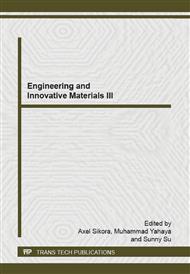p.31
p.36
p.40
p.45
p.50
p.57
p.65
p.71
p.76
Porous GaN for Gas Sensing Application
Abstract:
Porous wide bandgap semiconductors have been widely studied in the last decade due to their unique properties compared to the bulk crystals. GaN received attention from the researchers as an ideal material to fabricate chemical sensing devices due to its excellent properties such as high thermal, mechanical and chemical stabilities, large band gap and high breakdown voltage. In this work, porous GaN was prepared by ultraviolet (UV) assisted electroless chemical etching method. The samples used in this study were commercial n-GaN grown on sapphire (Al2O3) substrates. The samples were initially cleaned in 1:20 NH4OH:H2O, followed by second cleaning in 1:50 HF:H2O and final cleaning in 3:1 HCl: HNO3 and these samples were etched in HF:H2O2:CH3OH under UV illumination for 60 minutes. The structural properties was characterized using Scanning Electron Microscope (SEM). Hydrogen sensor was subsequently fabricated by depositing Pd Schottky contact onto the porous GaN sample. The effect of sensing dilute H2 gas with different concentration which is 1% and 2% H2 in a N2 gas ambient was analyzed. The Schottky barrier height of the gas sensor samples was reduced upon exposure to gas. The porous GaN resulted better sensitivity compared to the as grown GaN sample in H2 gas sensing.
Info:
Periodical:
Pages:
50-56
Citation:
Online since:
October 2014
Authors:
Price:
Сopyright:
© 2014 Trans Tech Publications Ltd. All Rights Reserved
Share:
Citation:


